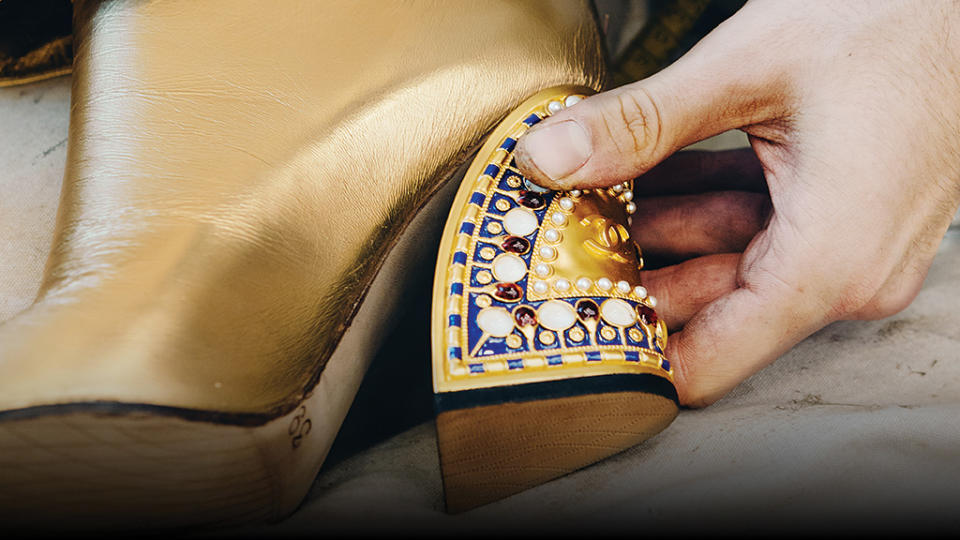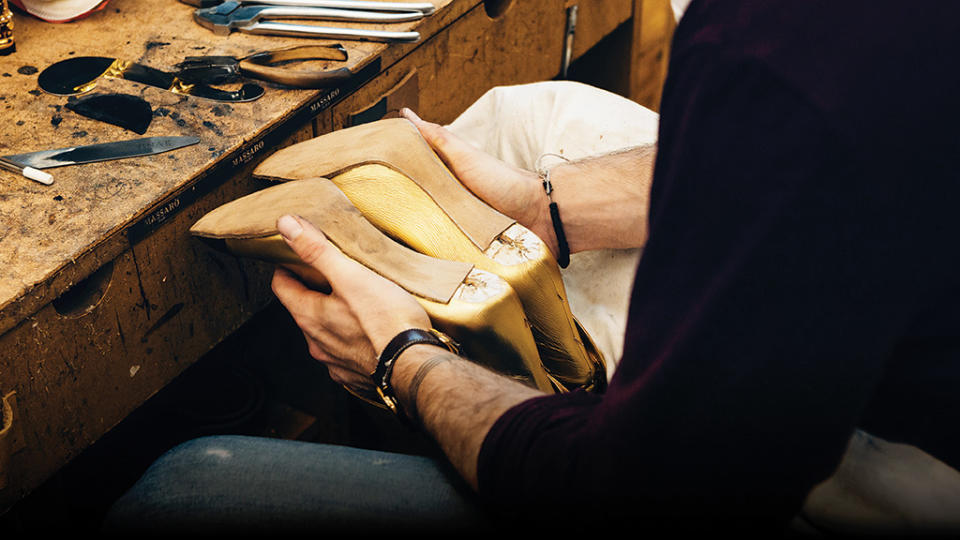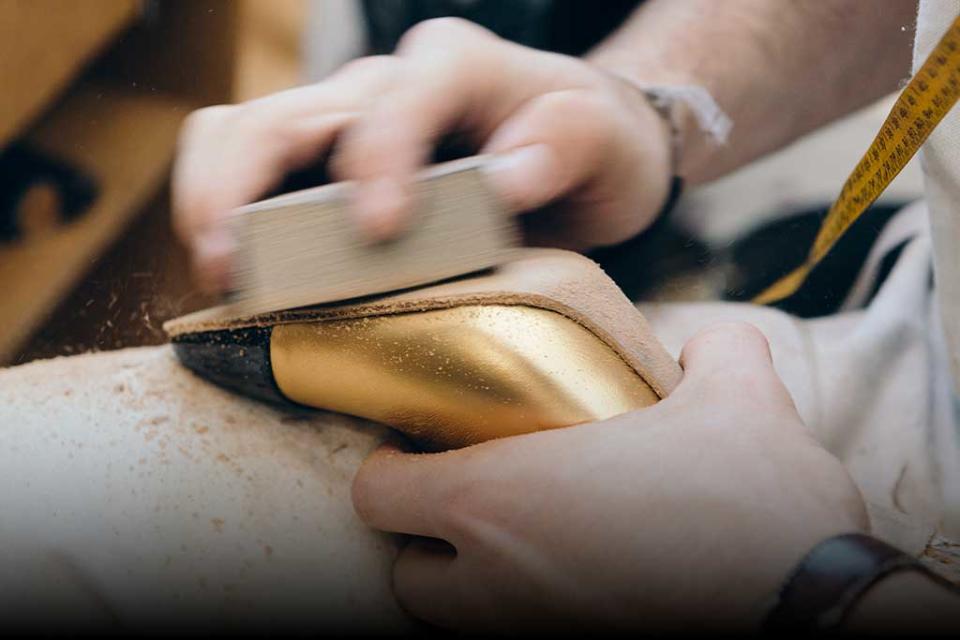Chanel Makes 3 Additions to Specialty Atelier Division Paraffection

Chanel has acquired two Italian leather goods makers and a French clothing manufacturer as it continues to bolster its network of specialty ateliers in order to secure its supply chain and guarantee future growth.
The French luxury brand has bought a 40% stake in Renato Corti, one of Italy’s biggest manufacturers of leather goods with factories in Florence and Milan, and a 40% holding in Mabi, another high-end handbag maker with facilities in Florence and San Daniele, Italy.
More from Footwear News
Shania Twain Pops in Purple Chanel Jacket, Matching Bra & Leather Boots at CMT Music Awards 2023
Priscilla Presley Dressed in All Black While on Her 'An Evening With' Tour in Manchester
In addition, it has taken a 34 percent stake in Grandis, a company that groups 12 workshops across France spanning tailoring, flou, lingerie, swimwear and leather. The three acquisitions, which were completed in January, represent a total investment of $169 million, Chanel said in its most recent annual report.
Bruno Pavlovsky, president of fashion and president of Chanel SAS, said the investments were part of the company’s policy of preserving traditional know-how by bringing specialized manufacturers in need of fresh investment into its Paraffection subsidiary, which now employs 5,000 people across 30 companies.
“If we want to remain the leader in luxury over the next 20 years, we have to make investments and take risks in areas we consider key for the future,” he said. “We are not necessarily looking to buy more companies, but rather to ensure these suppliers remain important contributors to the development of our products.”

Chanel
Speaking on the site of a new building in the north of Paris that will house several of Chanel’s specialty ateliers, Pavlovsky said the three companies in question had reached a turning point in their development for a variety of reasons, whether their owners were looking to retire or expand with a new investor.
“We continue to work with them as we have done for the last 30 years, except that now we are a privileged shareholder of these companies that will eventually be fully owned by Paraffection,” Pavlovsky added.
Unlike its rivals, Hermès International and Louis Vuitton, Chanel has split its handbag production between its French workshop in Verneuil-en-Halatte, France, where it is replacing its existing facility with a brand-new manufacturing site, and its partners in Italy.
“Joining forces with Corti and Mabi, which are two important Italian manufacturers, gives us a strong footprint for the years to come,” he said.
Earlier this year, Chanel acquired a stake in Italian tannery Samanta, a specialist in printed leather that supplied many of the materials used in its Egyptian-themed 2019 Metiers d’Art collection shown in New York last December, one of the last designed by the label’s late creative director, Karl Lagerfeld.
The company said at the time it would no longer use exotic skins, and Samanta filled the gap with its artfully printed and hand-finished creations. “We found this know-how absolutely exceptional. Today, we might use prints that resemble exotic leather, but tomorrow, it could be any type of print,” Pavlovsky said.

Chanel
He anticipated a revolution in the tannery business as consumers seek more environmentally sustainable alternatives.
“We are investing at the same time in several companies that are doing research and development, but the results won’t be ready for another 10 or 15 years, and at this stage, we have very few guarantees that we’ll be able to produce alternative materials,” he said.
“But having refocused on leather that is a byproduct of the meat industry, there’s a lot we can do with leather right now. I think the secret in the future will be a mix of approaches blending traditional leather, as we know it today, with new materials and finishes,” the executive predicted.
“I think tanneries are going to evolve more in the next five years than they have in the last 50 years. Everything is moving very fast. We want to make sure our tanneries have the means to keep up with and contribute to that transformation,” Pavlovsky added.
Chanel has stepped up the pace of investments in recent years, spending more than $1 billion in 2018 to make sure it remains at the top of the luxury pyramid.
Revenues totaled $11.12 billion in 2018, up 10.5 percent at comparable rates, driven by strong double-digit growth in the Asia-Pacific region — again placing it neck and neck with Louis Vuitton as the world’s biggest luxury brand.
Chanel paid $234 million for acquisitions, including $90 million on Spanish leather tannery Colomer Leather Group, $44.1 million on British swimwear brand Orlebar Brown, an undisclosed amount on a minority stake in Farfetch and a host of smaller purchases, including a 20% stake in Kenissi, a watch movement manufacturer.
As part of its investment drive, the luxury giant plugged money into everything from omnichannel services to stores, offices renovations, raw materials and extra staff. Its capital expenditures were up 130 percent from $439 million the previous year.

Chanel
Chief financial officer Philippe Blondiaux pointed to the high level of investment as evidence that Chanel was not for sale. “The level of investment is going to be sustained in 2019 and 2020,” he added.
Pavlovsky said that while Chanel was not on an acquisition spree, it would intervene to make sure that endangered suppliers are protected, citing the example of tweed, one of the company’s signature materials.
“There are fewer and fewer suppliers and manufacturers of yarns. The danger is that there won’t be enough of them around in the future to continue making Chanel’s magical tweeds,” he cautioned.
“So regardless of what shape that support takes — I don’t know whether it requires an acquisition or signing specific purchase agreements — what’s important to us is that we’re able to continue producing these tweeds. Chanel will do what it takes to make that happen,” he added.
The company’s sprawling new site in Aubervilliers, France, due to open in the third quarter of 2020, is emblematic of its commitment to craftsmanship. Designed by architect Rudy Ricciotti, it will group more than 600 employees over five floors and two basements.
At a ceremony on Tuesday marking the completion of the structural work on the 275,000-square-foot building, Pavlovsky revealed the site would be named 19M — 19 for the number of the Parisian district adjoining the site, and M for French words like “mains” (hands), “mode” (fashion) and “métier” (craftsmanship).
German street artist Andreas von Chrzanowski, aka Case Maclaim, has covered the 6,700 square feet of wall surrounding the building site with a mural paying tribute to the know-how of the artisans with several close-ups of hands at work.
The building will be home to embroiderers Lesage and Montex, shoemaker Massaro, feather and flower expert Lemarié, milliner Maison Michel, pleater Lognon, grand flou atelier Paloma and goldsmith Goossens. It will also house the lingerie and swimwear brand Eres.
The companies under the Paraffection umbrella, spread across France, Italy, Spain and Scotland, supply 35 brands worldwide, including 19 members of the Fédération de la Haute Couture et de la Mode, French fashion’s governing body. The division plans to hire between 80 and 100 people a year, Pavlovsky said.
In addition, the specialty unit will sign training partnerships with around 10 schools, including the Institut Français de la Mode, and hopes to foster exchanges with local schools, associations, professionals and residents.
“The idea is to create an open center that builds relationships and feeds off the energy of the outside world,” Pavlovsky said. “We have to stimulate interest in these careers, so it has to be a place where young people want to come.”
This story was reported by WWD and originally appeared on WWD.com.
Best of Footwear News
What Is Gisele Bündchen's Net Worth? Here's How Much Money She Makes & How She Spends It
COVID-19 Cancellations Are Back for Sports, Broadway, & Other Major Events
Sign up for FN's Newsletter. For the latest news, follow us on Facebook, Twitter, and Instagram.

